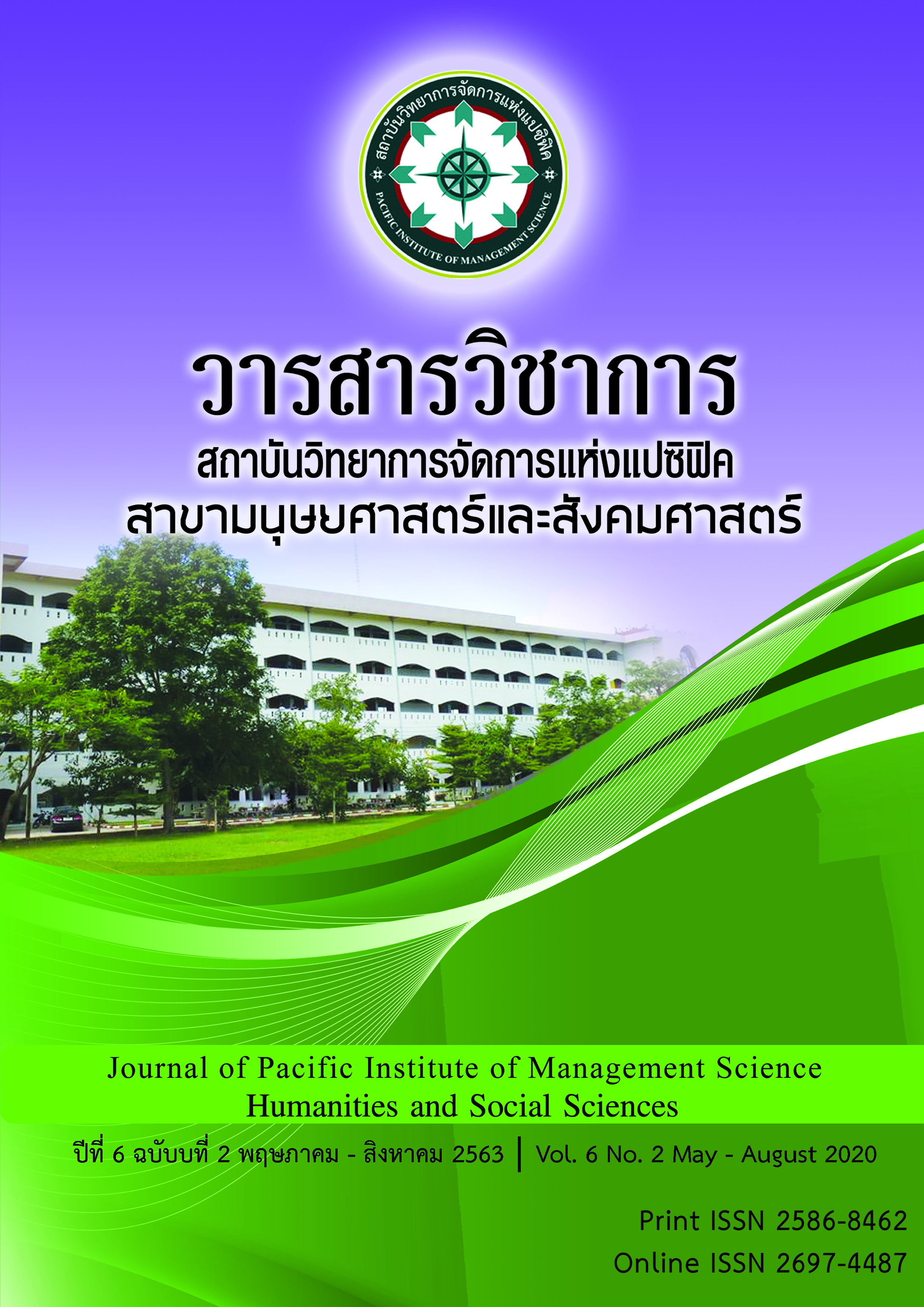ความสัมพันธ์ระหว่างคุณภาพบริการกับคุณค่าตราผลิตภัณฑ์ของ MK Restaurant ในกรุงเทพมหานคร
คำสำคัญ:
คุณภาพบริการ, คุณค่าตราผลิตภัณฑ์, เอ็มเค เรสโตรองต์บทคัดย่อ
การศึกษาความสัมพันธ์ระหว่างคุณภาพการบริการกับคุณค่าตราผลิตภัณฑ์ของ MK Restaurant ในกรุงเทพมหานคร มีวัตถุประสงค์เพื่อศึกษา (1) ถึงระดับของความคาดหวังและการรับรู้คุณภาพการ บริการของผู้บริโภค MK Restaurant ในกรุงเทพมหานคร (2) ถึงระดับของคุณค่าตราผลิตภัณฑ์ในใจ ของผู้บริโภค MK Restaurant ที่เป็นธุรกิจบริการ ระหว่างเพศชายและหญิงในกรุงเทพมหานครและ (3) ถึงความสัมพันธ์ระหว่างคุณภาพการบริการกับคุณค่าตราผลิตภัณฑ์ในใจของผู้บริโภคในกรุงเทพมหานคร กลุ่มตัวอย่างเป็นผู้บริโภคที่ได้เข้ารับบริการที่ MK Restaurant ในกรุงเทพมหานคร ทั้งเพศชายและเพศหญิง สุ่มแบบเลือกตามสะดวก (Convenience Sampling) จำนวน 400 ราย เครื่องมือที่ใช้ในการวิจัยเป็นแบบสอบถาม สถิติที่ใช้ในการวิเคราะห์ข้อมูล ได้แก่ ร้อยละ ค่าเฉลี่ย ค่าเบี่ยงเบนมาตรฐาน การทดสอบค่าที และการวิเคราะห์ค่าสัมประสิทธ์สหสัมพันธ์ผลการวิจัยพบว่า (1) ระดับของความคาดหวังและการรับรู้คุณภาพการบริการของผู้บริโภค MK Restaurant ในกรุงเทพมหานคร มีความแตกต่างกัน อย่างมีนัยสำคัญทางสถิติที่ระดับ 0.05 (2) ระดับของคุณค่าตราผลิตภัณฑ์ในใจของผู้บริโภค MK Restaurant ที่เป็นธุรกิจบริการ ระหว่างเพศชายและหญิงในกรุงเทพมหานคร ไม่แตกต่างกัน อย่างไม่มีนัยสำคัญทางสถิติ และ (3) ความสัมพันธ์ระหว่างคุณภาพการบริการกับคุณค่าตราผลิตภัณฑ์ในใจของผู้บริโภค ในกรุงเทพมหานคร มีความสัมพันธ์กันในระดับปานกลาง มีนัยสำคัญทางสถิติที่ระดับ 0.01
เอกสารอ้างอิง
กรุงเทพธุรกิจ (2556) “เอ็มเค” หวังติดแบรนด์อาเซียน 5 ปี. ค้นคืนวันที่ 31 กรกฎาคม 2556 จาก http://www.money.th.msn.com/Stock/stock.asps?cp-documentid=2533512582
ธานินทร์ ศิลป์จารุม ผศ. (2550). การวิจัยและวิเคราะห์ข้อมูลทางสถิติด้วย SPSS. กรุงเทพมหานคร บริษัท วี อินเตอร์ พริ้นท์
นิตนา ฐานิตธนกร และธนกฤต เศรษฐ์ศิริโชค (2555) “ปัจจัยที่มีผลต่อการตัดสินใจเลือกใช้บริการอู่ซ่อมรถยนต์”. วารสารวิชาการและวิจัย 6, 2(กันยายน) : 113
บุญเกียรติ ชีวะตระกูลกิจ (2552 ก ) “กลยุทธ์ผลิตภัณฑ์”. ในประมวลสาระชุดวิชาการวิเคราะห์ วางแผนและควบคุมทางการตลาด หน่วยที่ 8 หน้า 165 นนทบุรี มหาวิทยาลัยสุโขทัยธรรมาธิราช สาขาวิชาวิทยาการจัดการ
“เมื่อ MK ไม่ได้ขายแค่สุกี้”. ค้นคืนวันที่ 26 ตุลาคม 2561 จาก http://positioning.com/1154574
ยงยุทธ ฟูพงศ์ศิริขันธ์ (2554 ก) “กลยุทธ์ผลิตภัณฑ์”. แนวการศึกษาชุดวิชาการจัดการตลาดขั้นสูงและการวิจัยตลาด หน่วยที่ 4 หน้า 7 นนทบุรี มหาวิทยาลัยสุโขทัยธรรมาธิราช สาขาวิชาวิทยาการจัดการ
ยุพาวรรณ วรรณวาณิชย์ (2548) “การตลาดบริการ”. กรุงเทพฯ : สำนักพิมพ์มหาวิทยาลัยเกษตรศาสตร์.
“รายงานประจำปี 2560 บริษัทเอ็มเคเรสโตรองค์กรุ๊ป จำกัด (มหาชน)”. ค้นคืนวันที่ 8 พฤศจิกายน 2561 จาก http://investor-th.mkrestaurant.com/ar.html
ลัดดา วัจนะสาริกากุล (2550) “คุณภาพบริการทางด้านการตลาด”. วารสารการจัดการสมัยใหม่ 5, 1 (มกราคม - มิถุนายน) : 100 – 111
ศูนย์ข้อมูลกรุงเทพมหานคร (2543) รูปแบบการบริหารกรุงเทพมหานคร. ในหนังสืออนุสรณ์พระราชทานเพลิงศพ ว่าที่ร้อยตรี เสมอใจ พุ่มพวง หน้า 109-120 ค้นคืนวันที่ 5 พฤศจิกายน 2561 จาก http://203.155.220.230/m.info/bma_k/knw5.html.
ศิริวรรณ เสรีรัตน์. (2543). นโยบายผลิตภัณฑ์และราคา. กรุงเทพฯ : ธนรัชการพิมพ์.
ศิริวรรณ เสรีรัตน์ และคณะ , (2552). การบริหารการตลาดยุคใหม่ (Marketing Management). กรุงเทพฯ: Diamond In Business World
เสรี วงษ์มณฑา. (2540) ครบเครื่องเรื่องของการสื่อสารการตลาด. กรุงเทพฯ : วิสิทธิ์พัฒนา
Aaker, D. A. (1991). Managing Brand Equity : Capitalizing on the Value of a Brand Name. New York, NY. : The Free Press
Artur Baldauf, Karen S. Cravens & Gudrun Binder (2003). “Performance consequences of brand equity management: evidence from organizations in the value chain.” Journal of Product & Brand Management, 12(4), 220-236.
Bohrer F Monty (2007). “Discriminant analysis of Aaker's brand equity model on top-ofmind awareness/brand preference congruence in prospective hospital patients.” Anderson University.
Carman, James M. (1990). “Consumer Perceptions of Service Quality: An Assessment of The SERVQUAL Dimensions.” Journal of Retailing. 66 : 33-55.
Chris A. Myers (2003). “Managing brand equity: a look at the impact of attributes.” Journal of Product & Brand Management, 12(1), 39-51
Caruana, Albert. (2002). “Service Loyalty: The Effects of Service Quality and The Mediating Role of Customer Satisfaction.” European Journal of Marketing. 36 (7) : 811-828.
Crosby, P. B. (1988). Quality is free. New York: McGraw-Hill.
Gronroos, Christian. (1988). “Service Quality: The Six Criteria of Good Perceived Service.” Review of Business. 9 (3) : 10-13.
Haywood-Farmer, J. and Stuart, F. Ian. (1990). “An Instrument to Measure The Degree of Professionalism in A Professional Service.” Service Industries Journal. 10 (2) : 336-347.
Heskett, James L. (2002). “Guru’s View: Beyond Customer Loyalty.” Managing Service Quality. 12 (6) : 355-357.
James B. Wilcox, Debbie A. Laverie, Natalia Kolyesnikova, Dale F. Duhan & Tim H. Dodd(2008). “Facets of brand equity and brand survival: a longitudinal examination.” International Journal of Wine Business Research, 20(3), 202-214
Keller, K. L . (2003). Strategic Brand Management Building, Measuring, and Managing Brand Equity. Englewood Cliffs, NJ. : Prentice Hall.
Kish, P., Riskey, D. R. & Kerin, R. A. (2001). “Measurement and tracking of brand equity in the global marketplace – The PepsiCo Experience.” International Marketing Review, 18(1), 91-96.
Krishnan, B. C. & Hartline, M. D. (2001). Brand equity: Is it more important in service Journal of Service Marketing. 15(5), 328-342.
Kotler, Philip. (1994). Marketing essential. New Jersey: Prentice Hall.
Kotler, Philip. (2003). Marketing Management.11 th ed. Upper Saddle River, NJ: Prentice Hall.
Ladda Vatjanasaregagul. (2007). “The Relationship of Service Quality, Consumer Decision Factors and Brand Equity.” Dissertation. Nova Southeastern University.
Lau, Pei Mey., Akbar, Abdolali Khatibi and Yong, Gun Fie David. (2005). “Service Quality: A Study of The Luxury Hotels in Malaysia.” The Journal of Amarican Academy of Business, Cambridge. 7 (2) : 46-55.
Lewis, Robert C. and Booms, Bernard H. (1983). The Marketing Aspects of Service Quality. Chicago: American Marketing Association.
Lovelock, Christopher H. and Wright, Lauren K. (2002). Principle of Service Marketing and Management. 2 nd ed. Upper Saddle River, NJ: Prentice Hall.
Mosahab, Rahim. (2010). “Service Quality, Customer Satisfaction and Loyalty: A Test of Mediation.” Dissertation. Universiti Sains Malaysia.
Parasuraman, A., Berry, Leonard L. and Zeithaml, Valarie A. (1990). An Empirical Examination of Relationships in An Extended Service Quality Model. Cambridge, MA: Marketing Science Institution.
Parasuraman, A., Zeithaml, Valarie A. and Berry, Leonard L. (1985). “A Conceptual Model of Service Quality and Its Implications for Future Research.” Journal of Marketing. 49 (4) : 41-50.
Pyo, Sungsoo. (2001). Benchmarks in Hospitality and Tourism. New York: The Haworth Hospitality Press.
Ravi Pappu & Pascale G. Quester (2008). “Does brand equity vary between department stores and clothing stores? Results of an empirical investigation.” Journal of Product & Brand Management 17(7): 425-435
Regan, W. J. (1954). Management in the Public – Service. New York: McGraw – Hill.
Rust, Roland T. and Oliver, Richard L. (1994). Service Quality: New Directions in Theory and Practice. USA: SAGE Publications.
Stan Glaser (2008). "The role of branding in the value chain." International Journal of Physical Distribution & Logistics Management 38(9): 726-736.
VanAuken, B. (2002). The Brand Management Checklist. London, Kogan Page Limited.
Zeithaml, Valarie A., Parasuraman, A. and Berry, Leonard L. (1990). Delivering Quality Service: Balancing Customer Perceptions and Expectations. New York:
ดาวน์โหลด
เผยแพร่แล้ว
ฉบับ
ประเภทบทความ
สัญญาอนุญาต
บทความที่ได้รับการตีพิมพ์เป็นลิขสิทธิ์ของ สถาบันวิทยาการจัดการแห่งแปซิฟิค
ข้อความที่ปรากฏในบทความแต่ละเรื่องในวารสารวิชาการเล่มนี้เป็นความคิดเห็นส่วนตัวของผู้เขียนแต่ละท่านไม่เกี่ยวข้องกับสถาบันวิทยาการจัดการแห่งแปซิฟิค และคณาจารย์ท่านอื่นๆในสถาบันฯ แต่อย่างใด ความรับผิดชอบองค์ประกอบทั้งหมดของบทความแต่ละเรื่องเป็นของผู้เขียนแต่ละท่าน หากมีความผิดพลาดใดๆ ผู้เขียนแต่ละท่านจะรับผิดชอบบทความของตนเองแต่ผู้เดียว







